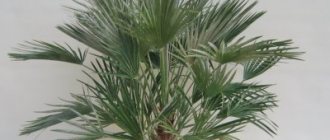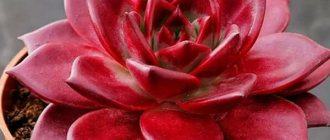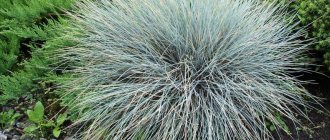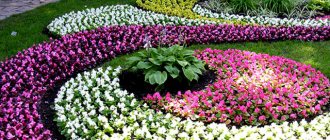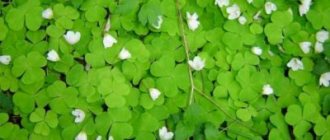Growing plants
Anastasia Zemlyanichko 04/11/2018 no comments
-1
( 22 ratings, average: 3.95 out of 5)
- 1 How do we study moss? 1.1 General characteristics of the plant
- 2.1 Features of growing moss yourself
- 3.1 How to care for plants?
Each of us has heard about such a plant as moss. It is rightfully considered the most ancient plants on Earth. Like any other plant, it has its own types and classification. Let's find out together what types of moss exist and what they are used for today.
How to plant moss on a plot instead of lawn grass? Where can I get it?
Moss is an inhabitant of damp and shaded forests, so we rarely encounter it in life and know little about this amazing plant.
In fact, once upon a time he could replace a medical bandage and show the way to lost mushroom pickers. Green home enthusiasts still use dried plants to insulate their homes. But we are more interested in the decorative side of moss: whether it can be used in landscape design and grown independently in the country. If you have ever walked barefoot through the forest, you may have noticed how pleasantly the soft moss springs under your feet. Moss is ideal for the garden or yard as it helps retain moisture and, unlike grass, does not need to be mowed. You can also grow moss on a fence, foundation or stones to create the atmosphere of a magical forest in your area. Growing moss requires only a little prep work, and then it will grow beautifully on its own for years.
Types of moss for a summer cottage
Each type of moss has its own “preferences” in terms of favorite habitats, which should be taken into account when planting them on the site. In addition, the external diversity of mosses is amazing and by arranging different varieties you can create a rich and varied landscape.
The most common type of moss is tortulla wall , which is more often called household moss. You can meet it literally everywhere, in a forest, a park, on a wall in a dark damp alley, etc.
The best place for tortulla is on limestone rocks and walls made of limestone rocks.
Kukushkin flax is an amazingly beautiful variety of moss that looks like miniature branches of pine needles. But finding it is much more difficult; to do this you will have to either spend money at a flower shop or go searching in the forest.
Looking carefully at your feet in the forest, you will probably come across an emerald blanket made of cuckoo flax. This variety of moss is incredibly beautiful and can easily compete with other ground cover plants, growing up to 15 cm in length. Cuckoo flax should be planted in the soil; it may not take root on a stone or tree.
Hypnum cypress is the second most common type of moss; in the forest it grows to form huge islands of emerald color. But even in an urban environment, it finds a place for itself on the walls and roofs of houses.
General information about moss
What do we know about moss? Moss belongs to the department of higher or above-ground plants. As a rule, it is a small plant with a length of about 50 mm. It has about 20 thousand species, has no flowers or root system, grows on all continents, including Antarctica, and reproduces by spores, that is, microscopic formations that mature in boxes located on the legs of the plant.
Moss plays a very important role in regulating the water balance of the landscape, as it is able to absorb and retain moisture. In this case, the mass of accumulated water can be 20 times greater than the moss’s own mass. In addition, moss purifies the air by absorbing exhaust gases, dust and smoke. Some other types of moss have bactericidal properties, slowing down or stopping the spread of harmful bacteria, which is why they are actively used in medicine. Moss is also resistant to decomposition and lasts a long time in a dried state.
It is these properties, as well as its beautiful appearance, that attract the attention of indoor plant lovers to moss.
Crushed dry moss can be added to the substrate when planting a plant to give it moisture capacity, and live moss can be used as a ground cover plant, that is, planted with another indoor plant for decorative purposes and to prevent the top layer of soil from drying out.
And in order to always have moss on hand, you can grow it at home. Moreover, this is done very simply and without any special material costs.
Collection and cleaning of moss
Moss for growing at home can be obtained in two ways.
The first way is to collect live moss from July to October in the places where it grows. In wildlife, mosses are usually found in shaded wooded areas, near a body of water. But moss often grows in urban areas if it has enough moisture.
Moss can grow on an old tree on the north side, covering the trunk from wind and cold. However, such moss is not suitable.
For further cultivation, it is better to collect moss growing on the ground, which is accustomed to the soil, and not to tree bark, for example, between paving slabs, in asphalt cracks or blind areas of a house, in general, where wipers do not work well.
I found such a wonderful nursery not far from my house. This is where I will collect moss.
Before you start collecting, it is better to wear gloves so as not to get your hands dirty and ruin your manicure. We carefully collect the moss with a spatula along with the soil and place it in a plastic bag. We try not to take home any living creatures that hide under the moss.
Immediately before planting, the moss should be rinsed well under warm running water, thus physically clearing it of debris and possible insects. But you can’t immediately plant moss collected outside on a houseplant, because harmful fungi, bacteria and insect larvae can live on it, which will simply kill your home flower. In addition, there is always the possibility that street moss simply will not take root at home. So he faces at least another month of quarantine and adaptation.
The second way to obtain moss for growing at home, in particular sphagnum, is to buy it in a store. In flower shops that sell orchids, dry bagged sphagnum is sold as an accompanying material. Very often in bags you can find not completely dried moss with living green shoots. This is the kind of moss that is suitable for further growing at home. It does not need to be further cleaned of pests.
Initial planting of moss
High-moor peat is well suited for the initial planting of moss. It is poor in nutrients, has an acidic environment, a porous, loose structure, a high degree of moisture capacity and breathability. In addition, peat is formed as a result of the decomposition of moss.
In order for moss to take root well at home, it needs to be provided with warmth and high humidity in the environment, that is, to create a greenhouse effect, so planting is carried out in a container with a closing top, for example, in a mini-greenhouse.
2/3 of the soil is filled into the greenhouse without an additional drainage layer.
To prevent fungal and bactericidal diseases, a fungicidal drug is dissolved in water in the proportions recommended by the manufacturer. This solution is poured onto the soil poured into the greenhouse.
We plant the collected moss in the moistened soil, distributing it over the entire surface, lightly compacting it.
To prevent harmful insects, planted moss is treated with an insecticidal preparation. At the same time, we do not forget about our own health - we exclude the possibility of getting the drug on the skin, in the eyes and in the mouth: using gloves, we try not to inhale the drug, we process the plant in a ventilated room, do not open our mouth, or better yet, use a respirator.
Next, cover the greenhouse with a lid and place it in a shaded place.
Instead of a mini-greenhouse, you can use, for example, some kind of plastic container for food, and replace the opaque lid with cling film. This is where I will plant purchased sphagnum.
Exactly the same as in the first case, I fill up the soil. I moisten the soil with water; it is possible without a fungicide, since purchased sphagnum has already been cleaned by the manufacturer. I plant green shoots from dried sphagnum in moist soil. After planting, I additionally spray the moss with water from a spray bottle, cover the container with cling film and also place it in a shaded place.
I do not recommend adding any nutrients, such as kefir, to the planted moss. I conducted such an experiment.
Kefir may have a good effect on the moss, but after 3 days the sour smell in the greenhouse will be simply terrible. In addition, all sorts of bacteria will begin to multiply there. In general, as a result of such an experiment, the entire contents of the greenhouse had to be thrown away.
Moss care
Further care of the moss is very simple. The greenhouse must always be humid. It is convenient to control the presence of moisture through the transparent lid. About once every three days we open the lid of the greenhouse for ventilation and spray the moss with settled water at room temperature, that is, the temperature of the room in which the moss itself grows. Mine is a glazed loggia with windows facing north. Additionally, you can spray the lid itself. Most likely, in the first month after planting you won’t have to water the moss at all; spraying will be quite enough.
If the planted moss is accepted, it will be noticeable within a week after planting. It will not dry out, but will gradually begin to grow over the surface of the greenhouse.
I noticed that it grows slightly at an angle towards the north.
The moss must be treated with an insecticide several more times over the course of a month. The number and frequency of treatments depends on the drug itself, so read the instructions carefully. In my case, in addition to the initial treatment during planting, 3 more treatments are needed with a weekly interval.
And about 2 weeks after planting, the moss needs to be watered again with a fungicide solution.
A month after planting, you can begin to open the lid of the greenhouse every day for ventilation, gradually increasing the time the moss is open.
In the future, the moss, without a cover, is watered every 3 days and sprayed daily. It doesn't need any fertilizer.
And this is what sphagnum looks like a month after planting.
And 2 months after planting, you can see how well it is growing.
Moss transplant
After cleaning the moss from possible pests and adapting to indoor conditions, it can be transplanted into a separate flower pot or replanted with another plant. In this case, 2 different plants in 1 pot will get along provided that they have the same care regimen - daily spraying and watering every 3 days.
This moss has been living with me for more than a year. Last year I also collected it on the street and after quarantine transplanted it into a flower pot. Despite the fact that moss is a short-lived and quickly drying plant, it reproduces well. This can be seen from the moss itself. The beige dry areas are last year's moss, and the young and green ones, one might say, are its children, this year's harvest. I am going to plant this moss on the bonsai tree during its replanting.
The soil into which we are going to transplant the moss is well moistened with water. Next, the moss is carefully collected with a spatula, along with soil particles, crushed and, as it were, scattered over the surface of the pot. Since moss does not have a root system, but reproduces by spores, chopping it will not harm it, but will allow the moss to be distributed evenly over the entire surface. You can sprinkle a little dry soil on top and spray it well.
Within a month after transplantation, the moss will begin to gradually germinate and will eventually grow over the entire surface of the pot.
Where can I get moss?
Thanks to the Internet, today you can buy anything; in addition, a considerable assortment of different varieties of moss can be found in flower shops in your city. But it’s much more interesting and reliable, from the point of view of the final result, to assemble it yourself.
The easiest way to find moss is in its natural environment, namely in shady areas of a forest or park. But if you take a closer look at your own area, it is likely to find that moss is already growing in your yard.
The most common type of moss, which is called household moss, can be found even in the city, in dark damp corners right on the asphalt.
Moss does not have a root system and reproduces exclusively by spores. At the same time, moss is perfect for replanting and grows quickly in a new place.
You need to carefully pry it off with a spatula or other sharp object and place it in the box.
Having collected the “seedlings”, cut pieces of moss should be kept for some time in a container of water so that they are nourished with moisture and become stronger.
If there are already places where moss grows on the site, then simply helping it expand its habitat is enough. To do this, you need to remove higher plants around it, clean the soil and walk through it with a rake; it is advisable to treat this area with herbicides and acidify the soil with peat or citric acid to pH 5.5.
When collecting moss, remember that moss taken from tree bark should only be planted on trees, and moss cut from the surface of the soil should be grown on the ground.
Plant selection
Despite the fact that mosses are epiphytes, they can grow on other plants; they cannot be called parasites, because they do not cause harm. These plants can carry out photosynthesis, producing their own nutrients from the air rather than from the soil. At the same time, moss can serve as an indicator of the poor condition of the tree and grow in damaged areas. It can grow on the bark of trees, usually on the north side where it is cool, damp.
The choice of moss is carried out taking into account climatic conditions. Some species do not tolerate cold well. The most commonly used mosses in gardening are:
- Hypnum is a leafy green plant, low-growing, tolerates the sun (not scorching), growing in damp places. Suitable for landscaping rocky surfaces, looks great between stones (garden paths).
- Dikran is a branched, loose, but tangled moss from green to brown, up to 8 cm high.
- Atrichum is star-shaped, green, dark green or brownish, up to 10 cm high, the leaves are wavy when wet. Can grow in areas with relatively dry soil and partial sun.
- Leucobrium is a decorative, cushion-shaped moss with a silvery coating.
- Polytrichum, sphagnum, thuidium, rakomitrium, and brachythecium are also decorative.
How to grow moss on the ground?
The easiest way to grow moss in soil is to take a small piece of moss somewhere and place it on the soil in the desired location. Thoroughly loosen the surface of the soil in the place where you are going to plant it, so that its threads get good contact with the ground. Moisten the area and place moss on it. It is necessary to press it well into the ground. You can even put a few light stones on top - this will help it stick better. Newly transplanted moss should be kept well hydrated for the first few weeks. Moss is not divided into varieties, but there is an opinion among practitioners that some types of moss grow better in the ground, while others grow better on hard rock. So it is wise to take your planting specimen from the same surface where you are going to plant it to minimize propagation problems (eg if you want to grow it on rocks, then the seedling should be taken from a rock, etc.) .
Source
On the rocks
You can also grow moss on rocks yourself. Sphagnum moss is suitable for these purposes. In this case, you can use both live and dried planting material.
For the first recipe you will need one glass of water and the same amount of milk. You need to add sphagnum moss to their mixture and mix everything in a blender. The liquid should have a thick consistency, like pancakes.
For the second recipe, take 0.5 liters of beer, 1 tsp. sugar and sphagnum, mix everything thoroughly with a blender.
In this way, a kind of “paint” is obtained from moss. Now it can be applied to various structures of natural origin. These could be stones, wooden parts. You can even complicate the task by making a stencil and using it to transfer drawings and inscriptions onto natural materials.
But do not forget that the objects to be decorated must be in favorable conditions for the growth of mosses. In addition, their surface should be rough, uneven, and in order for it to look natural, you should not apply paint to the entire surface; half will be more than enough.
© Author: Elena PROKOPENKOVA, agronomist-florist
Moss on the site
All varieties of moss can become a real source of pride for any site. By combining different varieties of this plant, you can create a diverse and rich panorama. Evergreen, easy-to-maintain moss can decorate any homestead. In areas where even grass does not grow, you can plant different types of moss and in 2-3 years the area will be transformed into an incredibly beautiful landscape. Even lawn grass can lose out to a green island of moss. There may be many flowering plants on the territory, and yet moss is not superfluous, since there is always a place for it. It also happens that for some people, moss grows on its own in the area, even without planting. Moss does not have a root system; its species differ in color, structure, and places of distribution, but they all reproduce by spores. When you replant moss, it grows very quickly. Professional biologists classify the following types of moss:
The use of moss in landscape design
Moss is an extremely popular plant in landscape design; its suede bushes will become a rich decoration of the garden plot. They improve the appearance of shady gardens. Moss beautifies the garden area, used on lawns, it is very attractive to the eye. Moss bushes are popular not only in landscape design, but also as a ground cover for weed control. In addition, moss is an ideal plant for cleaning the environment due to its ability to absorb toxins in wetlands. Moss is versatile, easy to grow and pleasing to the eye. Retro design is one way to use moss in landscape design. Cover sculptures, trees, paths with moss (it will hide uneven masonry from view), stones, etc.
The benefits of moss on the site
Moss has a number of positive features:
Moss in landscape design
Moss as an element of landscape design has a number of positive properties:
- In appearance, this plant is as attractive as a lawn, but requires significantly less effort and financial investment to maintain.
- Using moss, you can cover all unfilled areas of the territory and thereby give the landscape a finished look.
- Moss has a large number of shades and textures, which makes it possible to create original images and drawings with it.
- This plant is an integral part of oriental style design. By growing moss on the roof, you can provide coolness in the room and thus normalize the temperature inside the house.
There are several ways to use moss to decorate your landscape. One option is to create a retro design. Moss is used to decorate small architectural forms and sculptures located on the site. This method allows you to give the elements an aged look. In order to achieve the desired result in the process of decorating stone objects, you need to adhere to certain rules.
First of all, the object should be placed in a place favorable for the development of moss. This should be a shady and fairly moist area. In addition, it must be taken into account that moss can only develop on rough surfaces. Therefore, if the surface of a stone object is smooth, before proceeding with the design, the composition should be prepared in a certain way. Also, it is not recommended to decorate stone elements completely. It will be enough to decorate 50% of the surface or even less.
Moss will look quite impressive as a frame for ponds in the areas. During the design process, plants should be placed as closely as possible so that the joints between them are less noticeable. To hide the so-called “seams” you can use pine needles or stones. It is also possible to plant part of the shore of an artificial reservoir with moss. For this purpose, it is customary to use the sphagnum plant. Its color varies from light shades to red.
In addition to architectural elements and ponds, you can also decorate the soil. Using moss you can create a carpet-like surface. In addition, maintaining such a covering will not be difficult, since the soil makes it possible to introduce the nutrients necessary for the moss and provide the required level of moisture. This coating will make it possible to solve the problem of landscape unevenness, as it will hide all its shortcomings.
In addition, the moss coating does not require special care or correction, since it does not grow in height. When planting a large area, it is recommended to use moss of different shades. There are many landing options. You can plant it in the shape of a certain geometric figure, arrange the moss in a checkerboard pattern, or form a multi-colored carpet out of it.
Another option is to use moss to decorate garden paths. The plant is grown between stones and slabs of paved paths. Moss is also used to frame paths. This method is an alternative to planting flowers along paths, unlike moss, which does not require careful care.
A roof decorated with moss will have a spectacular look. In addition to its aesthetic value, such a roof also has practical significance, since the room will become cooler. Moss can also replace decorative flowers. It can be planted in flowerpots or formed into flower beds.
Growing moss on the site
It is best to plant moss in the fall, as the survival rate is higher at this time of year. To grow moss, you can use stones, both natural and artificial. Rocks with a porous surface are ideal for planting moss. The planting site should be shady.
Choosing a place for moss
Most mosses are known to thrive in shaded areas, as these are usually the wettest areas. When choosing a place to plant moss, you need to remember this so that the plants do not die.
You may find it useful
Planting moss
To plant moss on your site, you can purchase it in specialized stores or simply dig it up, bring it from the forest and plant it. Moss is a very wild plant, so you need to be careful about how much you take from forested areas and where you collect it (for example, it is illegal to take moss from national forests without a permit).
Rules for harvesting moss for growing
- When preparing a plant for planting, it should be taken into account that moss will only grow on a surface similar to the one from which it was taken. So, for example, moss from a tree will only grow on the tree, while moss from the ground can take root only on the ground.
- To prepare the material, you need to cut off a small amount of moss. An ordinary garden trowel will do for this purpose. When cutting, it is necessary to grasp the underlying substrate as well, so as not to damage the lower part of the material.
- Mature, well-grown fragments should be selected.
- Then the plant needs to be dried a little, two days will be enough for this. Then grind - finely chop or grind.
- For the development of this plant, an acidic, moist environment is required, so during the preparation of the growing mixture, moss is mixed with fermented milk products.
- The place where moss is planted should be in the shade. The rays of the sun in the morning and evening make the color of the plant more saturated, but exposure to the rays throughout the day dries out the moss. It is especially vulnerable to this factor during the first months after planting.
- Before planting, the area should be cleared of leaves and debris.
Moss care
Simple rules for caring for moss will help you grow a healthy and impressive plant.
Moss is a decoration for any place where it grows, because it is a year-round green plant. Moss is also popular because it requires very little water, is versatile, easy to grow, and pleasing to the eye. Moss is easy to plant and does not require much care. Obviously, moss is a very useful plant, and moss planted in an area looks very attractive and complements any look, which is why it is so popular in landscape design.
Source
Types of mosses
Moss is a fairly convenient plant for planting. It is able to grow and develop without fertilizers, and is quite resistant to diseases, pests and sudden temperature changes. In addition, it prevents soil erosion and helps eliminate weeds. Experts identify the following main varieties:
- Leafy mosses. About 95% of the entire class of plants belongs to this category. In turn, these mosses are divided into subclasses: andreaceae, briaceae, sphagnum. The main distribution areas are swampy areas and forests.
- Liver mosses are common in subtropical and tropical areas.
- Anthocerotic mosses are purely tropical plants.
Moss photo:
Moss garden: secrets of creating decorative green masterpieces at your dacha
Moss is an inhabitant of damp and shaded forests, so we rarely encounter it in life and know little about this amazing plant. In fact, once upon a time he could replace a medical bandage and show the way to lost mushroom pickers. Green home enthusiasts still use dried plants to insulate their homes. But we are more interested in the decorative side of moss: whether it can be used in landscape design and grown independently in the country.
“Velvet carpet” as a decorative decoration
Mosses are unusual both in their structure and in their way of life. Unlike other dacha flora representatives - trees, grass, flowering plants - they do not have roots or flowers, but outgrowths that replace leaves have a unique decorative effect.
A variety of colors, from bright green to red-brown, allows you to create unusual velvety lawns, decorate alpine hills and rockeries, “aging” brick fences, tree stumps and stone framing of ponds
The Japanese, who were attentive to detail, were the first to use moss in landscape design. They noticed that miniature thickets in a certain, comfortable environment for them live and develop no worse than garden plants, and in some cases, their appearance outshines them.
Back in the 14th century, Japanese monks created the Saihoji moss garden, which, slightly modified, still exists.
Various types of mosses and lichens cover small islands, stones, tree trunks, and soil with a thick multi-colored lawn, creating an atmosphere of peace and quiet.
The tradition of using moss in landscape design spread to Europe, and then to other continents, to all regions where the climate is conducive to the growth of these special plants.
The most popular decoration technique suitable for a summer cottage is the creation of mossy stone, which is part of a stone garden or rock garden. Half covered with green velvet, the stone takes on a completely different look - more ancient, mysterious, fabulous.
Mosses and lichens fit organically into the composition of coniferous forest trees: covering the lower parts of the trunks, they simultaneously protect them from drought and overheating
From the point of view of the possibility of decorating large and small forms, moss is universal. It perfectly “ages” statues, vases, fountains and garden sculptures located in the shade, but also serves as excellent additional protection for roofs and gazebos. And of course, as a cover plant it frames garden paths, small flower beds, ponds and stream banks.
Main types
Nowadays, whole species of mosses are known. Each type has its own characteristic features. Let's pay attention to several types:
- Rozhdestvensky . The name of forest moss was determined by the shape of its leaves. All its leaves are shaped like Christmas tree needles. Christmas moss is growing slowly. It can grow safely only under special conditions. The temperature for successful growth should not exceed 22 degrees. Externally, this view looks very beautiful. And all thanks to its needle-like leaves, which grow in layers and form excellent compositions;
- Fern . The leaves of this species are similar to those of a fern. Therefore, fern is often confused with moss. The fern is quite dense. It is better for him to grow in the shade. As a rule, the fern species is small in stature. Can be used for planting in the garden;
- Richia . One of the most common species, known all over the world. Richia have the shape of a ball. This species completely lacks roots and stems. The root, leaves and stem in this case replace the layers of twigs. Richia moss grows successfully when all conditions are met. For example, it needs good consecration and an aquatic environment. The intensity of consecration affects not only the growth process, but also the color. Under the influence of consecration, the color of richia may change significantly. The standard shade is bright green;
- Hypnosis moss . Grows on stones, tree trunks, on the ground and on branches. The hypnotic species is in dire need of shade. Although it is able to withstand solar attacks. Great for constructing a variety of garden paths and lawns located in the garden or around the house;
- Key . Like richia, key moss is known to a wide range of people and is distributed almost throughout the world. The exception is Australia. The color of the key species depends entirely on the power of the consecration. It may be red or it may be dark green. In addition to consecration, color is significantly influenced by the composition of the soil in which it resides. The decorative moss itself consists of stalks on which there are many leaves. The key type does not require supernatural conditions of containment;
- Peat . This species is most often found in swamps. It is the swamps that are its main habitat. Peat mosses come in a variety of colors. Shades come in red or green. It is often used to maintain the required level of soil moisture in flower pots. In some cases, they decorate garden ponds near the house;
- Leptodiccium coastal . Another type of moss with a very interesting name. Its name comes from the stems. The appearance is very original. The same stems are located far from each other. Their vertical direction gives the plant a real airiness that will not leave anyone indifferent. The coastal species is very difficult to confuse with another species of these plants. Coastal plants are considered unpretentious plants in terms of care. The acceptable temperature for it is no more than 28 degrees. It feels good in water, for example, in a pond near the garden;
- Weeping . This species received this name due to the shape of the structure of its branches. The branches look like a weeping willow. The height of such moss is no more than 50 cm. The weeping species comes from China. Later it was brought to Europe. The plant's habitat can be both driftwood and various pebbles near the country garden. The optimal temperature for normal life should not exceed 28 degrees;
- Dicranum . This species prefers to grow on concrete walls and stones. Today there are several species of dicranum moss. All types differ from each other in shades, as well as in the shape of the leaves. Dicranum is not tall. Its height is 4 cm;
- Javanese . One of the most famous species. Javanese plants are considered the most unpretentious in terms of care. In most cases they are used by aquarists. Java moss does not require a specific temperature regime. It feels great in both dark and light ponds. Its stems are intertwined. During growth, the stems stretch down;
- Polytrichum vulgaris . This type is used in a wide variety of areas of our lives. It has proven itself well both in medicine and in the field of garden design. Habitats: swamps and woodlands;
All of the listed moss species are used in different fields and fields of activity. Some people decide to grow their own moss at home. Let's find out how to do this and what advice you should listen to.
Features of growing moss yourself
Growing moss at home is not difficult, but it requires certain skills and knowledge. You should also have some tools on hand. For successful cultivation you will need:
- a transparent container (such a container can be a round vase or a round bowl);
- blender;
- water, buttermilk or milk.
The process of growing at home consists of several stages. Before growing, it would be a good idea to familiarize yourself with the tips below:
- Before planting, you should clear the selected area of dirt, debris and leaves.
- When preparing a plant for planting, remember that the growing area must correspond to the previous habitat of the moss. For example, a plant taken from trees will take root exclusively on the tree. For example, in the garden. It is useless to grow it on the ground.
- The planting site should not only be similar, but also be in the shade. Continuous exposure to the sun will simply dry it out.
- The growing medium should be moist and acidic.
Now let’s reproduce the growing order.
Secrets and rules of growing moss
If you are an experienced florist and have already learned how to grow flowers, care for lawns and harvest a rich fruit harvest in the fall, you can safely start growing moss and decorate your garden decor or fence with it.
Beginning designers can also grow mosses or lichens on their own, having learned the basics of caring for unusual representatives of the flora.
Where is the best place to place a moss garden?
As you know, moss loves partial shade and a large amount of moisture, so before purchasing decorative species in a store or collecting them yourself in the forest, make sure that your country estate has an area that meets these requirements.
For example, this could be a small area of coniferous or mixed forest in which pine, spruce, larch or fir trees grow.
As a rule, the branches of coniferous trees create the necessary partial shade, and the soil contains a sufficient amount of water. If a light pine grove is located on dry sandy soil, it is not suitable for growing mosses
The north side of a gazebo or building, where the sun shines early in the morning or late in the evening, is also suitable for creating a velvet carpet. A small amount of ultraviolet light can be beneficial - under the sun's rays, the peculiar leaves change color and acquire many interesting shades.
An excellent place for the first planting of moss is garden soil. From small fragments of mossy turf you can assemble an amazingly beautiful lawn, shimmering in different colors.
Moss pads can be planted both under tree canopies and in open but shaded areas - they form beautiful lawns that are unique in appearance
If there is a wetland left at your dacha by chance, moss can become the main decorative element for decorating it. A small pond with aquatic plants is placed in the center of the site, and the banks of the reservoir and the surrounding area are decorated with the help of various types of bryophytes and lichens.
A scattering of moss-covered stones, a mossy old cracked jug, and a decorative boat with its nose buried in the soft mossy shore fit harmoniously into such an extraordinary landscape.
Shade and moisture are not the only conditions for the successful growth of moss. Experienced florists recommend first studying the acidity of the soil. Ideally, the pH value should be between 5 and 6.5 units.
Preparation of plant material
So, we have found a site for the experiment, all that remains is to purchase the plant itself. We will not engage in growing moss with spores, but will immediately find adult plants - at least in order to immediately see the result. We have two available options:
The first option is good because it will be possible to purchase species of different colors and growth characteristics. However, there is no certainty that they will quickly take root on your site, so be sure to ask the seller where and under what conditions the proposed specimens were grown. Purchased moss is fed with fertilizers and treated against diseases in order to better settle in after the move.
Plants from the nearest forest will most likely quickly get used to their new place of residence if it is similar to their previous place of growth. Where can you find moss in its natural habitat? First of all, in the nearest coniferous forest.
Select the types that you will use: if you decide to decorate a stone, remove the pads from the stones; tree moss will decorate tree trunks, and a green carpet covering the soil will be useful for decorating alpine slides and lawns
Moss thickets can also be found in the city. Visit old parks and squares, ancient architectural monuments with high stone fences, overgrown ponds - somewhere you are sure to stumble upon a thick green carpet.
Try to find as many different species as possible, differing in height, shade and growing conditions - by experimenting with them, choose the most resistant plants suitable for your site
Choose mature, healthy specimens that are rich in color and thick. Do not pull up plants or cut off just the tops. The correct thing to do would be to dig up the pad from all sides and carefully separate it from the base.
Be careful not to damage the decorative top and bottom growths. Carefully place the collected pads (pieces of mossy turf) into a basket with a damp piece of cloth at the bottom. After filling the basket, be sure to cover the samples so that they are not exposed to direct sunlight and the moisture does not evaporate ahead of time.
The nuances of proper planting of moss
Let's start with the fact that moss planted in the fall takes root much better. You can try spring planting, and then analyze the difference in the results obtained. Perhaps your conditions are ideal for spring work.
It is better to prepare the filler soil in advance. Make a nutrient substrate: mix chernozem and peat in equal parts, add a small amount of clay and expanded clay. Peat and expanded clay will help retain moisture during dry periods.
If moss is found in a forest or on the shore of a lake, take the soil from the old place of growth - it will be ideal for adaptation to the new territory
Next we perform the following steps:
As you can see, the planting rules are quite simple. Let's look at a few more features.
When planting moss on an alpine hill, additional initial fixation will be required so that pieces of turf do not fall down. To secure them to the slope, we simply stick thin sticks (toothpicks will do) or pieces of wire. Later, when the moss grows in, they can be removed
On old stumps, only those specimens that were removed from a similar surface - rotting wood - will nest well.
On the contrary, if you find a beautiful, spectacular specimen in the forest on a rotten stump and want to decorate your country house composition with it, you will have to acquire an old stump, a fallen log or a piece of wood with traces of rotting
Sometimes a smooth, mossy surface looks boring and monotonous. To revive the composition, we use partner plants. Suitable for residents of coniferous forests:
These tips are good for a mossy lawn, but now let’s look at how to grow moss on stones. To do this, you will need a mixture of pieces of moss, water and forest soil. The listed components are mixed in a blender and then applied to the surface of the stone.
At first, additional care will be required. You can cover the stone with film for several days, arranging brief ventilation from time to time.
A scattering of stones looks beautiful and laconic against the background of a green carpet, but it is better to choose ordinary gray cobblestones rather than bright granite fragments
Sometimes a mixture is prepared on a biological basis. Add a little sugar, kefir, water to the mossy turf, beat it and coat the stone with a sticky mass. The products fix the plant particles and play the role of a nutrient mixture.
Instead of kefir, you can use yogurt or beer, and instead of sugar, any sweet syrup. This method is used to decorate not only stones, but also stone fences, brick buildings, and wooden fences.
With good growth of moss on concrete, stone and wooden surfaces, you can create graffiti, ornaments and “living” drawings from its fragments
Decorative or stabilized moss
Decorative, or stabilized, moss is a new design solution that can decorate any home. This moss is used to make paintings and panels, which are attached to boards and hung on the wall. This composition looks very original. Stabilized moss (or sleepy) does not require watering or other special care.
Advantages of decorative moss:
- retains its appearance for 15 years;
- does not require special lighting;
- being in a state of sleep, moss does not grow, which means it does not need to be pruned;
- dust does not settle on it;
- does not cause allergies;
- moss is not toxic;
- resistant to mold and fungi, and not susceptible to diseases.
On an industrial scale, moss is collected by hand. This selection of material allows you to control the balance of the ecosystem. After collection, the moss is thoroughly cleaned of remnants of grass and dirt, and then subjected to a stabilization process. In fact, the plant is put into a dormant state. But it is precisely thanks to the stabilization process that moss can retain its color and properties for a long time, but not grow. The essence of the process is that a special solution based on glycerin is introduced into the moss. As a result, the decorative moss turns out to be soft, elastic and very beautiful.
Is it possible to make decorative moss with your own hands? There is nothing complicated in the process itself. Another thing is that to create a large-scale painting you will need a lot of moss. If you have enough material available, you can make stabilized moss at home.
Icelandic moss is most suitable for growing sleepy moss. This is what is most often used in decoration.
To prepare a solution for creating decorative moss you will need:
- moss - 3 handfuls;
- kefir - 0.5 liters;
- sugar - 2 teaspoons;
- hydrogel - 2 teaspoons;
- purified water - as needed.
All components are loaded into a blender and blended for two minutes. Now you need any natural base, for example, a board or cork tile. The prepared solution must be applied to the surface of the substrate, after which moss should be laid out. It will take five weeks for a sufficient layer of moss to form. All this time, the moss must be kept under the film, thus creating a greenhouse.
While the moss is not sleeping, it needs to be looked after: water it periodically and avoid direct sunlight. If you are not happy with the color of the plant, you can paint it with natural paints. To prepare a mixture that will put moss to sleep, you will need boiling water and glycerin. They must be diluted in a ratio of 2:1, respectively. You should get a thick mass, which should be poured over the entire surface of the moss. In a month, the bryophyte will fall asleep and can be hung in a permanent place.
Buying decorative moss is not a cheap pleasure. The average price per kilogram is $28. If you buy moss in the form of tiles, the price of the panel is $400 per square meter.
If you have any questions, we suggest watching the video, which describes stabilized moss in more detail.
How to care for mossy lawns?
Like any lawn, flower bed or rock garden, moss requires regular care, which includes moistening, thinning, updating and basic cleaning. Moss grows quite slowly: the first young pads will appear no earlier than 4-5 weeks after planting. They will appear near the “parental” nests on all sides or in one direction, the most favorable for growth.
At this stage, you should adjust the size of the “mat” if you need it to be within strictly limited limits. Until the young shoots have grown, the plantings should be kept moist.
It happens that plants do not take root and die. No problem: pick a different species and plant it in the same place. Sometimes moss dries out due to lack of moisture or strong exposure to sunlight. Perhaps abundant watering will revive dried plants
Unlike a traditional lawn, moss grass does not require regular mowing. However, it is necessary to ensure its cleanliness. Forest debris will not only spoil the aesthetics of the decorative covering, but will also cause the death of moss or the appearance of unsightly “bald patches.”
It is very simple to protect a velvet rug from autumn leaves: spread a fine mesh over the entire lawn, and then simply roll it up along with the leaves.
